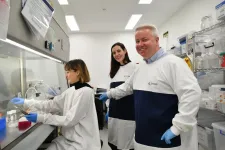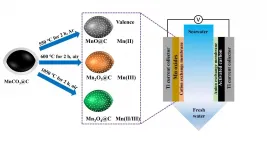Moving one step closer to personalized anesthesia
EPFL researchers have developed a device that can continuously measure the blood concentration of propofol - one of the main compounds used in anesthetics - in patients as they are being operated on.
2021-05-28
(Press-News.org) Anesthesia may be an exact science, but it's not yet fully personalized. Anesthesiologists use a variety of methods to calculate the right dose for a given patient: clinical studies, medical databases and laboratory measurements, for example. However, every individual responds to anesthetics in a different way, and there's no way of knowing what that response will be until the anesthetic is administered.
Personalizing dosage
Today patients often receive supplemental doses of an anesthetic during their operation based on their reaction. The role of anesthesiologists is to make sure that a patient doesn't wake up too soon and has no memory of the procedure, but they must use the smallest possible amount of drugs, which can often be taxing on the body. In reality, the supplemental doses are administered with no knowledge of what the actual drug concentration already is in the patient.
To solve that problem, researchers at EPFL's Integrated Systems Laboratory (LSI) in the School of Engineering, working in association with the Lausanne University Hospital (CHUV) and the Polytechnic University of Turin, have developed a system that can measure propofol concentration in patients as they're being operated on and adjust the doses they're administered accordingly. "Scientists have been working for years to develop sensors that can instantly measure blood concentrations of compounds in anesthetized patients, so that doctors can personalize the doses," says Sandro Carrara, a professor at the EPFL School of Engineering. "Propofol is one of the main compounds used in anesthesia, but it's also one of the hardest to measure."
A smart syringe
The researchers' device looks like a huge syringe. Its needle contains sensor electrodes that measure propofol concentrations in a patient's blood, while the electronics for the sensors - developed at LSI - are contained in a central control box. The sensors' measurements are analyzed using artificial intelligence.
Accurate measurements thanks to machine learning
"The reason why propofol is so hard to measure is that it tends to stick to a needle's tip, distorting the results," says Carrara. His team tried out various methods for resolving this issue before finally deciding on machine learning. Thierry Buclin, pharmacology professor and chief of the CHUV's clinical pharmacology division, says: "Propofol is one of the best anesthetics out there, but getting the dosage just right can be complicated. So an easy-to-use system that can monitor propofol concentrations in the operating room would be a major step forward in surgery and intensive care."
The LSI researchers have confirmed the accuracy of their device through in vitro tests on human blood samples. The next step will be to conduct tests in vivo. Their findings have been published in IEEE Transactions on Biomedical Circuits and Systems.
INFORMATION:
ELSE PRESS RELEASES FROM THIS DATE:
2021-05-28
Scientists from the Wellcome Sanger Institute and the University of Cambridge found that in children with neuroblastoma - a cancer of immature nerve cells - treatment with platinum chemotherapy caused changes to the genome that could then cause leukaemia in some children later on.
The findings, published 27th May 2021 in Blood could lead to an ability to identify which children are more likely to develop the secondary cancer. This in turn could lead to changes in their treatment plan to either avoid these risks or take measures to prepare.
Secondary blood cancer is a challenging complication of childhood neuroblastoma cancer treatment. Every year around 100 children in the UK are diagnosed with neuroblastoma*, ...
2021-05-28
The group of experts includes Professor and Academician of Tallinn University of Technology Jarek Kurnitski, who said that improving ventilation can be regarded more broadly as a paradigm shift equal in scale to the transformation in the standards of drinking water supplies and food hygiene. "There has long been no doubt that you can get infection when you drink water or eat food that has been contaminated. Now we must work towards providing clean air so we can breathe safely," Kurnitski said.
He added, "Researchers see updating of ventilation standards, ventilation requirements based on the probability of infection and more efficient and flexible ventilation systems as a solution. High air change rates are required only in the event of an epidemic, at any ...
2021-05-28
Varying immune response to vaccinations could be countered with microbiota-targeted interventions helping infants, older people and others to take full advantage of the benefits of effective vaccines, Australian and US experts say.
A comprehensive review in Nature Reviews Immunology concludes that evidence is mounting in clinical trials and other studies that the composition and function of individuals' gut microbiota are "crucial factors" in affecting immune responses to vaccinations.
"Never before has the need been greater for robust and long-lasting immunity from our vaccination programs, particularly in low and middle-income countries, and for populations at increased ...
2021-05-28
Researchers at the University of Adelaide are concerned video sharing platforms such as YouTube could be contributing to the normalisation of exotic pets and encouraging the exotic pet trade.
In a study, published in PLOS ONE, researchers analysed the reactions of people to videos on YouTube involving human interactions with exotic animals and found those reactions to be overwhelmingly positive.
The researchers analysed the reactions - via text and emoji usage - in comments posted on 346 popular videos starring exotic wild cats and primates in 'free handling situations'.
These situations involved exotic animals interacting with humans or other animals, such as domestic cats and dogs. The videos examined received ...
2021-05-28
Public use of parks and reserves increased only slightly during last year's COVID-19 national lockdown despite gyms and sports facilities shutting down, a University of Queensland study found.
UQ School of Biological Sciences PhD candidate Violeta Berdejo-Espinola surveyed 1000 people in Brisbane, measuring their use of urban green space and the benefits people associated with visiting the areas during lockdown.
"People all around Brisbane, myself included, noticed a boom in park use in 2020, but while more people ventured into local parks, many folks were left indoors," Ms Berdejo-Espinola said.
"Thirty-six ...
2021-05-28
Professor YAO Huajian's research group from the School of Earth and Space Sciences of the University of Science and Technology of China (USTC), in cooperation with Dr. Piero Poli from Grenoble-Alpes University of France, combined the unique resolution reflected body waves (P410P and P660P) retrieved from ambient noise interferometry with mineral physics modeling, to shed new light on transition zone physics. Relevant work was published in Nature Communications.
The subduction of oceanic slabs is an important process of the earth's internal material circulation. Studying the ...
2021-05-28
Recently, the researchers from Institute of Solid State Physics, Hefei Institutes of Physical Science (HFIPS) of the Chinese Academy of Sciences, by using valence engineering, developed three manganese oxides as electrodes with different Mn valences for high-performance capacitive desalination.
Reverse osmosis and thermal distillation are widely used to treat salt water with high salt concentration, but they have disadvantages including high energy consumption and high cost.
As an alternative method, capacitive deionization (CDI) technology can remove charged ions ...
2021-05-28
University of Virginia School of Medicine researchers have shed new light on how our brains develop, revealing that the very last step in cell division is crucial for the brain to reach its proper size and function.
The new findings identify a potential contributor to microcephaly, a birth defect in which the head is underdeveloped and abnormally small. That's because the head grows as the brain grows. The federal Centers for Disease Control estimates that microcephaly affects from 1 in 800 children to 1 in 5,000 children in the United States each year. The condition is associated with learning disabilities, developmental delays, ...
2021-05-28
Waking up just one hour earlier could reduce a person's risk of major depression by 23%, suggests a sweeping new genetic study published May 26 in the journal JAMA Psychiatry.
The study of 840,000 people, by researchers at University of Colorado Boulder and the Broad Institute of MIT and Harvard, represents some of the strongest evidence yet that chronotype--a person's propensity to sleep at a certain time --influences depression risk.
It's also among the first studies to quantify just how much, or little, change is required to influence mental health. ...
2021-05-28
Until now, competing types of robotic hand designs offered a trade-off between strength and durability. One commonly used design, employing a rigid pin joint that mimics the mechanism in human finger joints, can lift heavy payloads, but is easily damaged in collisions, particularly if hit from the side. Meanwhile, fully compliant hands, typically made of molded silicone, are more flexible, harder to break, and better at grasping objects of various shapes, but they fall short on lifting power.
The DGIST research team investigated the idea that a partially-compliant ...
LAST 30 PRESS RELEASES:
[Press-News.org] Moving one step closer to personalized anesthesia
EPFL researchers have developed a device that can continuously measure the blood concentration of propofol - one of the main compounds used in anesthetics - in patients as they are being operated on.





